District Trendline, previously known as Teacher Trendline, provides actionable research to improve district personnel policies that will strengthen the teacher workforce. Want evidence-based guidance on policies and practices that will enhance your ability to recruit, develop, and retain great teachers delivered right to your inbox each month? Subscribe here.
In last month’s Teacher
Trendline, we discussed policies affecting substitute teachers. This
month, we continue the discussion by analyzing teacher leave policies across
the NCTQ Teacher Contract Database. Specifically, we focus on sick and personal leave,
as well as policies allowing teachers to carry over leave and those that differentiate
the amount of leave teachers receive depending upon their experience.
General leave
While it may seem
straightforward, teacher leave is a complicated topic. The variation in
categories and sub-categories makes it hard to compare districts’ leave
policies. For more details on this, make sure to check out our report, A Closer Look
at Teacher Leave Benefits: An Apples to Apples Comparison.
In order to make fair
comparisons, we have coded leave from the districts in our Teacher Contract Database into “general” leave and “other” leave.
So— what is “general” leave? NCTQ
defines it as leave taken for any relatively routine reason (as opposed to a
highly unusual reason or emergency). This category includes leave that
districts call sick or personal leave, as well as other kinds of common leave,
such as for funerals or days of religious observance.
Across 119 districts in our
Teacher Contract Database, the average amount of general leave offered is 13.5
days.
Hawaii is the only district in the Teacher Contract Database
that does not specify the amount of general leave its teachers can use during
the school year. Instead, the district
only specifies that within the leave offered to teachers, six days may be used
for personal/professional reasons.
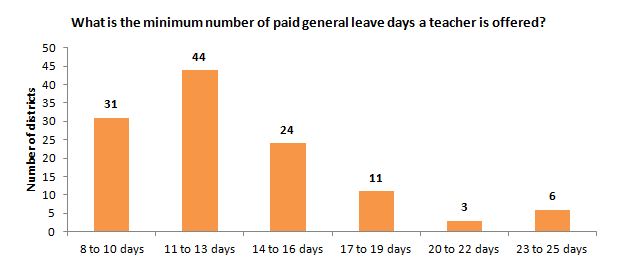
The graph above shows the
minimum number of paid general leave days offered to teachers. While most
districts (88 percent) offer all of their teachers the same, fixed number of
leave days, some districts offer different amounts of leave to different
categories of teachers, usually based on levels of experience.
Four districts have
particularly unique leave policies worth noting.
The leave policy in Alpine School District (UT) is the most unique in the Teacher Contract Database. It offers its teachers either eight or 180
days of general leave! In this district, non-tenured teachers receive eight
days of general leave, while tenured teachers receive 180 “Health and
Disability” days over the course of
their careers. If they use all of this sick leave before they are ready to
retire, they then receive 21 days of leave to use over the next two years. After
those two years are up, they qualify for another 180 days of leave. Apart from
this “Health and Disability” leave, all teachers receive five personal days; however,
teachers must pay $45 for each personal day taken.
Teachers in North Carolina also
have an unusual leave package. State law requires that teachers get between
11.7 to 21.7 days of “annual vacation” leave (determined by years of experience)
in addition to their sick leave (10 days) and personal leave (two days). According
to the Guilford
County’s personnel handbook, the district “values the contributions,
health and well-being of each employee. The purpose of paid annual vacation
leave is to allow and encourage all employees to take time off from work.”[1]
This kind of vacation leave is not something you generally see in district
contracts or board policies.The
first 10 days of “annual vacation” leave earned by teachers must be
taken on set days agreed upon by the local Board of Education. Notably, none of this leave can be taken on an instructional day or on
a day when a substitute is needed to cover the teacher’s absence.
Sick and personal
leave
Most leave offered to teachers is categorized as
sick leave, even though many districts make it clear that sick leave can be
used for many reasons other than personal illness. In 70 percent of the districts
in the Teacher Contract Database, teachers are offered between 10 to 12 days of
sick leave.
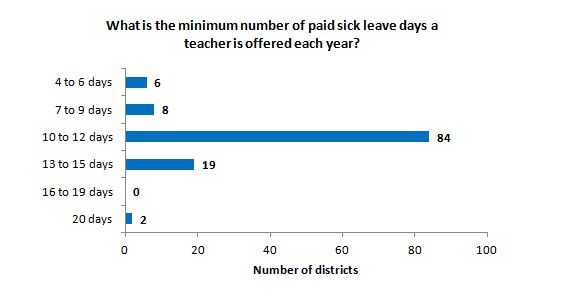
Two districts— Burlington School District (VT) and Hartford Public Schools— stand apart from others by offering teachers a very generous
amount of sick leave — 20 days.
With regard to personal
leave, the majority of districts allocate personal leave separately from sick
leave. However, 52 districts (43 percent of districts in the Teacher Contract Database),
designate part of a teacher’s sick leave as days which may be used for personal
leave. The one district in the Teacher Contract Database that does not address personal leave within its contract is Kansas City Public Schools (MO).
Regardless
of whether or not districts separately allocate personal leave or designate it
as part of a teacher’s sick leave, most districts—65 percent— offer teachers a
minimum of one to three days of personal leave.
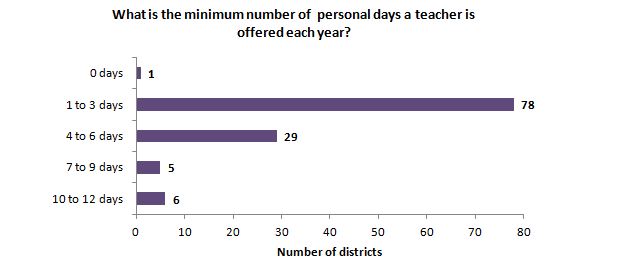
Pittsburgh Public Schools
is the one district that offers teachers no personal days, at least initially in
a teacher’s career. First – and second-year teachers are not yet eligible for personal
days; teachers who begin their third year of continuous service then get two
personal days.
Leave allocations and
teacher experience
The vast majority of districts (101 districts)
do not differentiate teacher leave by experience. The policies of the remaining
19 districts in the Teacher Contract Database that do differentiate leave by a
teacher’s experience are listed below:
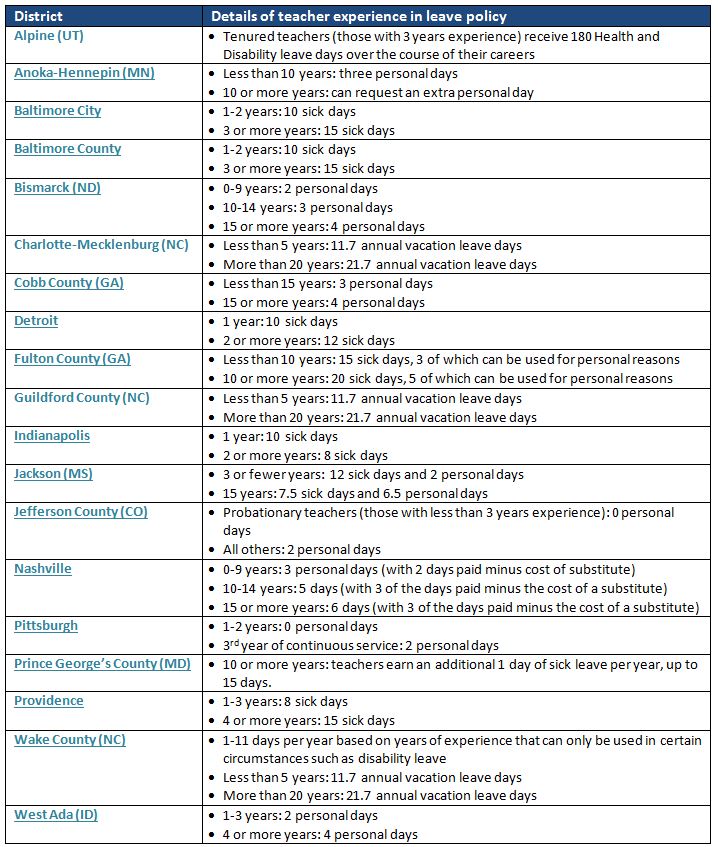
While most of the districts
above increase the number of sick, personal and/or leave days as teacher
experience increases, the leave policies in Indianapolis
and Jackson (MS) are
noteworthy. In both districts, teachers are provided fewer days for illness as seniority increases.
Leave carryover
Almost all districts in the Teacher
Contract Database allow sick leave to carry over from year to year. Hawaii is the only district that does
not explicitly allow the carryover, but that is due to the fact that its
leave allocations, apart from personal leave, are not clearly stated within its
contract.
The policies regarding
whether personal leave can be carried over are not as consistent among
districts. Only about half of districts —
53 percent— allow personal leave to be carried over from one year to the next.
Within this group of districts, 19 districts explicitly cap the number of
personal days that can be accrued.
Of the 43 percent of districts that do not allow
personal days to be carried over from year to year, four districts— Clark County (NV), Dayton (OH), Granite (UT) and Toledo (OH)— pay out for unused personal days at the end of
the school year.
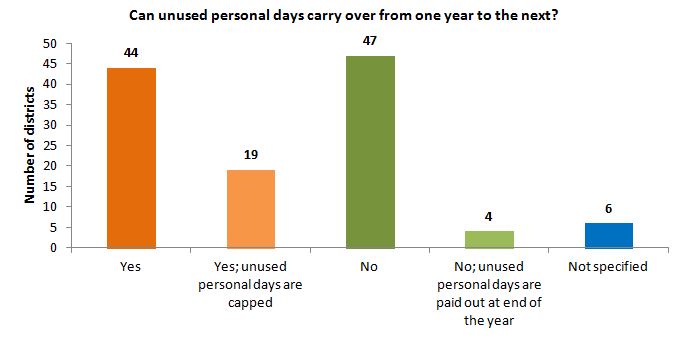
[1] Guildford County Schools, 2014-2015 Personnel
Handbook, pg. 81:
http://www.nctq.org/docs/Personnel_Handbook_2014-15_Fin_08_14_2014.pdf














